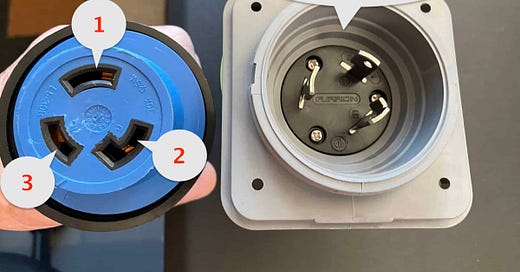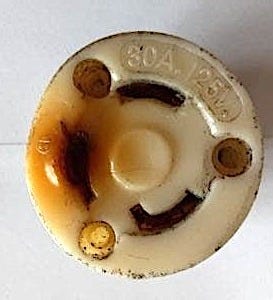Why does the neutral always burn up?
Is this actually what’s happening, or is it just an urban myth?
Hello Mike,
Why is it always the Neutral contact on a 30-Amp, 120-Volt Twist-Lock plug that has the meltdown?
Thank You - Roger S
Dear Roger,
And that’s the 64 thousand dollar question. Why does the Neutral contact seem to burn up more than the Hot contact in most Twist-Lock meltdown failures. I’ve noticed this effect in the dozens of pictures of L5-30 twist-lock plugs sent to me. My rough estimate is that around 80% of these meltdowns are the neutral contacts.
Why does the Neutral seem to fail more than the Hot contact?
Electrically, there’s no reason I can think of. Any currents should be exactly equal in the Neutral and Hot conductors. So it’s not like the Neutral contact is carrying more amperage than the Hot contact.
The only thing I’ve casually observed of is that the Hot contact slot appears to be slightly larger than the Neutral slot. But I don’t believe the Hot and Neutral contacts themselves are any different. So is there something causing less contact area? Is the neutral contact a different material? Does it mate differently compared to the hot contact? What’s happening?
1=HOT 2=Ground 3=Neutral
The Truth is Out There…
Post your comments below and email any pictures you have of burned 30-amp twist-lock plugs to mike (at) noshockzone (dot) org with the subject “Twist-Lock” and I’ll see if any patterns stick out.
Let’s play safe “out there”… Mike









I work for an RV repair facility and I have also seen this problem on the 50 amp plugs and surge protectors. Usually on the male side of the plug. I have my techs inspect the power cords when a trailer comes in for repair. We have even opened up a couple of these damaged power cables and found the insulation on the neutral wire to be melted from extreme heat.
I have also had to replace a 50 amp breaker panel because all of the neutral wires had burned up and melted the plastic box.
Mike, This is something we noticed over the years on duplex receptacles as well, it was usually the neutral. I chalked it up to most electricians being right handed and better able to get the right side screw more secure, that's all I could come up with.